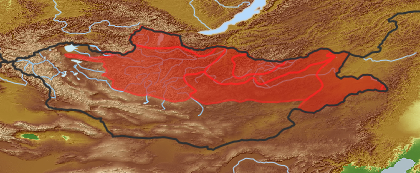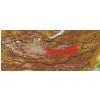| Class: | angiosperms |
| Order: | Asparagales |
| Family: | Convallariaceae |
| Genus: | Polygonatum |
| Scientific name: | Polygonatum odoratum (Mill.) Druce |
| Name acc. to: | Gubanov 1996 |
| Herbar: | list records   |
| Description: | Plant 30-50 cm high, stem angular. Leaves alternate, glabrous, 10-12x3-5 cm. Flowers axillary, paired on pedicels. Fruit a black berry. |
| Link to Flora of China: | http://www.efloras.org/browse.aspx?flora_id=2&name_str=Polygonatum+odoratum |
| open map in a new window |  |
| Habitat: | Larch, pine and birch forests, shrubberies, rocks (Grubov 2001). |
| Habit (i)general appearance of a plant | |
| Growth form: (i)Herb, shrub, tree or climber. | herb (i)Herbaceous, erect plant, up to 2m high, mostly with a leafy shoot; if perennial, shoots die to the ground each season, shoots are not woody
example: Artemisia pectinata 
perennial (i)Living for several to many years, as opposed to annual and biennial
|
| Parasite status: (i)Is the plant a half- or full parasite? | no parasite/saprophyte (i)Plant fully autonomous, leaves with chlorophyll
example: Most plants, Ranunculus  inherited by family Convallariaceae: no parasite/saprophyte inherited by family Convallariaceae: no parasite/saprophyte
|
| Water or terrestrial plant: (i)Where do the plants grow? | terrestrial (i)Plant grows on dry land
example: Orostachys spinosa  inherited by family Convallariaceae: terrestrial inherited by family Convallariaceae: terrestrial
|
| Leaf (i)expanded, usually photosynthetic organ of a plant (including phylloclades) | |
| Leaf development: (i)Structure and development of leaves. | flattened blade (i)Cross-section of lamina flat, plain  inherited by family Convallariaceae: flattened blade inherited by family Convallariaceae: flattened blade
common leaf (i)Green, often divided in blade and petiole
example: Cotoneaster  inherited by family Convallariaceae: common leaf inherited by family Convallariaceae: common leaf
with green leaves (i)Plant with green leaves  inherited by family Convallariaceae: with green leaves inherited by family Convallariaceae: with green leaves
|
| Leaf arrangement: (i)Arrangement of leaves at the stem. | alternate (i)One leaf per node; distiche: arranged in two vertical rows, equitant
example: Phragmites    inherited by genus Polygonatum: alternate inherited by genus Polygonatum: alternate
|
| Shape of blade: (i)Easy for simple leaves. In compound leaves use the general shape of leaflet. Always check the ground for largest leaves of a plant. To be worked out: how to handle pinnate leaves? | lanceolate (i)Lance-shaped; much longer than wide, with the widest point in the middle or below   inherited by family Convallariaceae: lanceolate inherited by family Convallariaceae: lanceolate
|
| Leaf margin: (i)Structure of leaf margin (or that of a leaflet in case of compound leaves). Attention: Here we ask for the leaf margin, defined as all those dissections that separate the leaf for less than one third of its length or width, whatever is smaller. To be worked out: how to handle margin of pinnate leaves? | entire (i)Plain margin, not toothed
example: Iris   inherited by family Convallariaceae: entire inherited by family Convallariaceae: entire
|
| Leaf veination: (i)Arrangement of the main veins of a leaf. | parallel (i)Most veins arranged parallel to the length of leaf, mostly no pronounced main vein (usually in elongate to linear leaves)
example: Most Monocotyledonae, Plantago, Veratrum, a lot of Caryophyllaceae looks like that.   inherited by order Asparagales: parallel inherited by order Asparagales: parallel
|
| Flower (i)reproductive portion of the plant, consisting of sepals, petals, stamens, and pistils | |
| Flower appearance and pollination: (i)General appearance of the flower. | attractive, animal-pollinated (i)attractive and coloured flowers, mostly large, attracting surely animals
example: Trollius, Rosa, Chamaerhodos  inherited by family Convallariaceae: attractive, animal-pollinated inherited by family Convallariaceae: attractive, animal-pollinated
|
| Perianth arrangement: (i)Attention: in some plants, flowers may be dimorphic in different ways (dioecious or gynodioecious). If flowers vary, record the characters of the most showy flowers. | simple, similar (i)Only one type of perianth leaves (tepals)
example: Tulipa   inherited by family Convallariaceae: simple, similar inherited by family Convallariaceae: simple, similar
|
| Flower symmetry: (i)Symmetry of the perianth leaves. Attention: to assess this character, look on sepals, petals and stamens, but neglect carpels and ovary. | radiary, regular (actinomorphic) (i)More than two axis of symmetry
example: Saxifraga: 5; Iris: 3   inherited by family Convallariaceae: radiary, regular (actinomorphic) inherited by family Convallariaceae: radiary, regular (actinomorphic)
|
| Flower form: (i)common forms of flowers ? Veronica | simple (flat) - Do not confuse with inflorescences as in some Asteraceae (i)Petals spread out, flower appearing flat
example: Mollugo, Trientalis, Pulsatilla, Saxifraga   inherited by family Convallariaceae: simple (flat) - Do not confuse with inflorescences as in some Asteraceae inherited by family Convallariaceae: simple (flat) - Do not confuse with inflorescences as in some Asteraceae
|
| Spur: (i)A hollow, slender, sac-like appendage of the perianth leaves, storing nectar. | no spur (i)Flower without appendage
example: Peganum  inherited by family Convallariaceae: no spur inherited by family Convallariaceae: no spur
|
| Stamen number: (i)Attention: We ask for the reproductive organs of the flower dispersing pollen. Count only fully fertile stamens, not staminodia (e.g. Parnassia). | 6 (i)
example: Veratrum, Smelowskia, Juncus  inherited by family Convallariaceae: 6 inherited by family Convallariaceae: 6
|
| Stamen fusion: (i)To which degree are the stamens fused? Attention: Whereas the pollen sacs itself are often free., their stalks (filaments) may be fused. Here, we count them as fused if they are together over at least one thirth of their length. | free (i)Stamens with separate bases
example: Malus  inherited by family Convallariaceae: free inherited by family Convallariaceae: free
|
| Ovary position: (i)For entirely or partly fused carpels, describe their position in relation to the insertion point of perianth leaves (best done by doing a longitudinal section of a flower). | superior (hypogynous) (i)Base of carpels attached above insertion point of perianth leaves, carpels free or fused
example: Delphinium, Anemone    inherited by family Convallariaceae: superior (hypogynous) inherited by family Convallariaceae: superior (hypogynous)
|
| Inflorescence (i)flowering part of a plant, describes the arrangement of the flowers on the flowering axis | |
| Appearance: (i)Outer look of the inflorescence. | axillary (i)Usually several inflorescences in axillary shoots or single flowers in leaf axils, main shoot remains mostly leafy
example: Tragopogon, Aconogonon
|
| Fruit (i)the seed bearing organ, with or without adnate parts; a ripened ovary and any other structures which are attached and ripen with it. Aggregate fruits are handled like simple fruits for determination. | |
| Type of fruit: (i)Common fruit types (including pseudocarp). | Indehiscent fruits  inherited by genus Polygonatum: Indehiscent fruits inherited by genus Polygonatum: Indehiscent fruits
Solitary fruits (i)     inherited by genus Polygonatum: Solitary fruits inherited by genus Polygonatum: Solitary fruits
berry (i)Fleshy fruit with several to many seeds in the flesh
example: Tomato   inherited by genus Polygonatum: berry inherited by genus Polygonatum: berry
|
| Root / shoot below ground (i)plant part below ground (in most cases), including below ground shoots, without leaves | |
| Root type: (i)Organisation of the roots. | homorhizous (i)Many equal roots
example: Monocotyledonae  inherited by order Asparagales: homorhizous inherited by order Asparagales: homorhizous
|
| Storage in below-ground structures: (i)Rhizomes or bulbs. | storage rhizomes (i)Horizontal, root like structures with scale leaves or their scars, these clearly thicker than the bases of above-ground shoots
example: Petasites, Iris  inherited by family Convallariaceae: storage rhizomes inherited by family Convallariaceae: storage rhizomes
|
| Distribution (i)region where the plant is likely to be found | |
| Distribution (Veg. Zones): (i)acc. to Grubov 1952 | Khubsgul (i)In distribution data often named as '1' 
Khentei (i)In distribution data often named as '2' 
Khangai (i)In distribution data often named as '3' 
Mongol-Daurian (i)In distribution data often named as '4' 
Great Khingan (i)In distribution data often named as '5' 
Middle Khalkha (i)In distribution data often named as '8' 
East Mongolia (i)In distribution data often named as '9' 
|